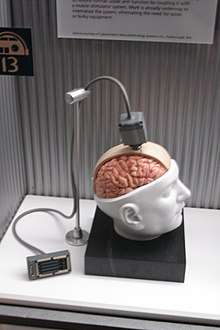Stent-electrode recording array
Stentrode (Stent-electrode recording array) is a small stent-mounted electrode array that is permanently implanted into a blood vessel in the brain without the need for open brain surgery. It is being developed to hopefully function as a brain–computer interface (BCI) for people with paralyzed or missing limbs, who will use their neural signals or thoughts to control powered exoskeletons and robotic prosthesis.[1]
The device was conceived by Australian neurologist Thomas Oxley who has been developing the medical implant since 2010, using sheep for testing. The FDA is reviewing plans to start human trials in the US starting in 2019.[2]
Overview
Neurologist Thomas Oxley has been developing the implant since 2010 through a company he founded called Synchron.[3][4] The small implant is an electrode array made of platinum that is mounted on a nitinol endovascular stent. The device measures about 5 cm long and a maximum of 4 mm in diameter.[5] The implant is capable of two-way communication, meaning that it can both sense thoughts and stimulate movement, essentially acting as a feedback loop within the brain, which offers potential applications for helping people with spinal cord injuries and control robotic prosthetic limbs with their thoughts.[6][7][8]
The Stentrode device is implanted via the jugular vein into a blood vessel near the cortical tissue near the motor cortex and sensory cortex, so open brain surgery is avoided.[3] Insertion via the blood vessel avoids direct penetration and damage of the brain tissue. As for blood clotting concerns, Oxley says neurologists routinely use permanent stents in patients' brains to keep blood vessels open.[3] Once in place it expands to press the electrodes against the vessel wall close to the brain where it can record neural information and deliver currents directly to targeted areas.[5] The signals are captured and sent to a wireless antenna unit implanted in the chest, which sends them to an external receiver. The patient would need to learn how to control a computer operating system that interacts with assistive technologies.
The Stentrode technology has only been tested on sheep, and the device and procedure are currently under FDA review.[9] Oxley expects to start clinical trials on humans sometime in 2019[5] to help paralyzed people regain movement by enabling them to operate a motorized wheelchair or even a powered exoskeleton. Selected patients are people with paralyzed or missing limbs, including people who have suffered strokes, spinal cord injuries, ALS, muscular dystrophy, and amputations.[3][5]
See also
- Cortical implant
- Neuralink
- Neurorobotics
References
- "Minimally Invasive "Stentrode" Shows Potential as Neural Interface for Brain". DARPA. 2016-02-08. Retrieved 9 February 2016.
- This Neural Implant Accesses Your Brain Through the Jugular Vein. Dan Robitzski, Futurism. 7 April 2019.
- 5 Neuroscience Experts Weigh in on Elon Musk's Mysterious "Neural Lace" Company. (PDF) Eliza Strickland. Harvard University. 12 April 2017.
- Synchron. Accessed on 31 December 2018.
- Stimulating the brain – without major surgery. Catriona May, The University of Melbourne. Published by Persuit. 4 December 2018.
- Focal stimulation of the sheep motor cortex with a chronically implanted minimally invasive electrode array mounted on an endovascular stent. Nicholas L. Opie, Sam E. John, Gil S. Rind, Stephen M. Ronayne, Yan T. Wong, Giulia Gerboni, Peter E. Yoo, Timothy J. H. Lovell, Theodore C. M. Scordas, Stefan L. Wilson, Anthony Dornom, Thomas Vale, Terence J. O'Brien, David B. Grayden, Clive N. May, and Thomas J. Oxley. Nature - Biomedical Engineering, Vol. 2, 3 December 2018, pp: 907–914 doi:10.1038/s41551-018-0321-z
- New device to get people with paralysis back on their feet. University of Melbourne. 8 February 2016.
- Implant Stimulates Brain From Inside a Blood Vessel. Megan Scudellari.
- A digital spinal cord that streams your thoughts. Thomas Oxley, TEDxSydney.

